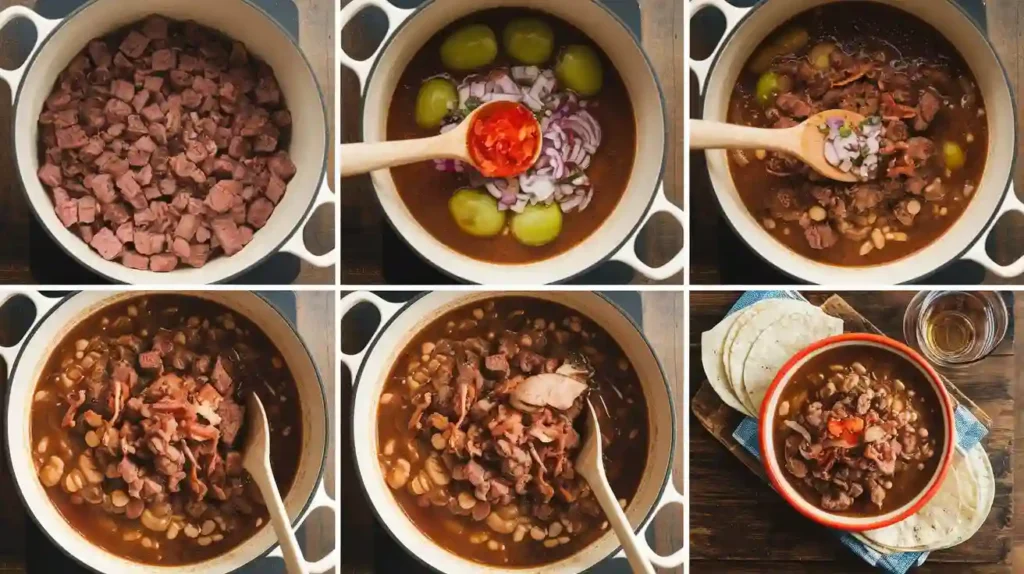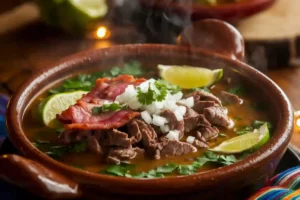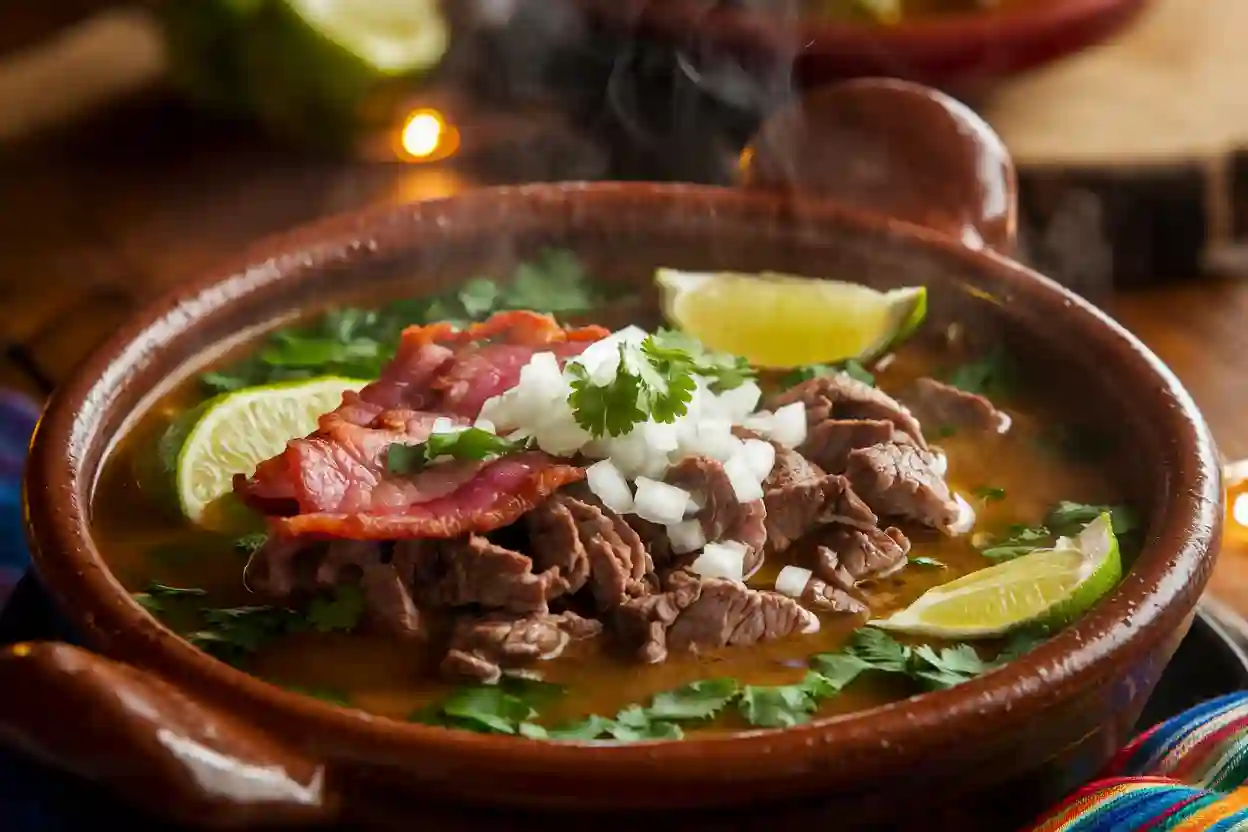If you’ve never tasted carne en su jugo, you’re in for a treat! This rich and flavorful dish from Guadalajara, Mexico, is a hidden gem in Mexican cuisine. Unlike other stews, carne en su jugo (which translates to “meat in its own juice”) is a brothy, deeply savory dish made with finely chopped beef, crispy veal bacon, and tender beans. The broth is typically flavored with tomatillos, chilies, and spices, creating an irresistible combination.
This guide dives deep into everything you need to know about carne en su jugo—its origins, ingredients, traditional preparation, and where to find the best versions. Whether you want to cook it at home or seek it out at a restaurant, you’ll gain all the insights you need. Let’s begin with the basics!
What is Carne en su Jugo?
The Meaning Behind the Name
The name carne en su jugo perfectly describes what makes this dish special. The meat is cooked in its own juices, resulting in a rich, concentrated flavor. Unlike thicker stews like birria or pozole, this dish has a thinner, brothy consistency. It’s a comforting, umami-packed meal that warms you from the inside out.
A Signature Dish from Jalisco, Mexico
Although many Mexican dishes have gained international fame, carne en su jugo remains a local favorite, especially in Guadalajara, the capital of Jalisco. It’s often considered one of the city’s best-kept culinary secrets. Many restaurants in Guadalajara specialize in this dish, perfecting their own versions over decades.
What sets Jalisco’s version apart is the use of finely chopped beef instead of large chunks. This allows the meat to absorb more flavor while maintaining a tender texture. The addition of veal bacon and beans adds depth, making it a hearty yet well-balanced dish.
Ingredients and Traditional Carne en su Jugo Recipe – Step-by-Step Guide
Making carne en su jugo at home is easier than you think! By following this step-by-step guide, you’ll be able to create an authentic, flavorful bowl of this Jalisco specialty.
Ingredients You’ll Need
For an even richer flavor, consider using chuck steak, which is well-marbled and adds depth to the broth. Learn more in our Ultimate Guide to Chuck Steak Recipe.
To prepare a classic carne en su jugo, gather the following ingredients:
| Ingredient | Quantity |
|---|---|
| Flank or skirt steak (finely chopped) | 1.5 lbs |
| veal bacon (diced) | 5 slices |
| Tomatillos (husked and chopped) | 6 |
| Garlic (minced) | 3 cloves |
| Onion (chopped) | 1 medium |
| Jalapeño or serrano pepper (optional, for heat) | 1 |
| Pinto beans (cooked) | 1 cup |
| Beef broth or water | 4 cups |
| Cilantro (chopped) | ½ cup |
| Worcestershire sauce | 1 tbsp |
| Soy sauce | 1 tbsp |
| Salt and pepper | To taste |
| Lime wedges (for serving) | 2 |
| Radishes (sliced, for garnish) | Optional |
| Tortillas (for serving) | Optional |

Step 1: Cook the veal bacon for Extra Flavor
Start by cooking the diced veal bacon in a large pot or Dutch oven over medium heat. Stir occasionally until the veal bacon becomes crispy. Remove it from the pot and set aside, but leave the veal bacon fat—this adds incredible flavor to the broth.
Crispy bacon adds a distinctive smoky flavor to the dish. If you’re a fan of veal bacon recipes, try these smoked bacon-wrapped veal recipes for a quick and delicious appetizer!
Step 2: Brown the Beef in Its Own Juices
Using the same pot with the veal bacon fat, add the chopped beef and cook until it releases its juices. Stir frequently to prevent sticking. Once the meat turns light brown, it’s ready for the next step.
Step 3: Blend the Broth Base
In a blender, combine the tomatillos, onion, garlic, Worcestershire sauce, soy sauce, and jalapeño (if using). Blend until smooth. Pour this mixture into the pot with the beef, then add the beef broth. Stir well.
Step 4: Simmer and Add Final Ingredients
Let the broth simmer on low heat for 30-40 minutes, allowing the flavors to meld. Add the cooked pinto beans and crispy veal bacon back into the pot. Stir gently and let it cook for another 5-10 minutes.
Step 5: Serve and Garnish
Ladle the carne en su jugo into bowls and top with fresh cilantro, sliced radishes, and a squeeze of lime. Serve with warm tortillas or crusty bread for the perfect meal!
This savory, tangy, and deeply satisfying dish is best enjoyed hot. Next, let’s explore some creative variations of this traditional recipe.
Variations of Carne en su Jugo
While the traditional carne en su jugo recipe is already a masterpiece, different regions and home cooks have put their own spin on it. Whether you’re looking for a healthier version or a spicier take, there’s a variation for you!
Regional Differences: How It’s Made Across Mexico
Although Jalisco is the birthplace of carne en su jugo, other Mexican states have adapted the recipe to their local flavors. Some versions include:
- Zacatecas style – Uses a darker broth with added spices for a bolder flavor.
- Northern Mexico variation – Often includes charred poblano peppers for a smokier taste.
- Mexico City version – Served with extra toppings like avocado and crumbled queso fresco.
Modern Twists – Low-Carb, Vegetarian, and Other Adaptations
If you’re looking for a healthier alternative, try these modifications:
- Low-carb version – Skip the beans and serve it with a side of roasted cauliflower or zucchini noodles.
- Vegetarian version – Swap the beef for mushrooms and lentils, and use vegetable broth instead.
- Spicy version – Add extra chilies like arbol or chipotle for an intense heat boost.
Restaurant-Style vs. Home-Cooked Versions
Restaurants tend to slow-cook the broth for hours, creating an even richer and more concentrated flavor. However, home-cooked versions allow for customization—adjust the salt, spice level, or thickness to your preference!

Authentic Carne en su Jugo
Equipment
- Dutch Oven
- Blender
Ingredients
Main Ingredients
- 1.5 lbs flank steak finely chopped
- 5 slices bacon diced
- 6 tomatillos husked and chopped
- 1 onion chopped
- 3 cloves garlic minced
- 1 jalapeño or serrano pepper optional, for heat
- 1 cup pinto beans cooked
- 4 cups beef broth
- 1 tbsp Worcestershire sauce
- 1 tbsp soy sauce
- salt and pepper to taste
- 1/2 cup cilantro chopped
- lime wedges for serving
- radishes sliced, for garnish
- corn tortillas optional, for serving
Instructions
- In a large pot, cook the diced bacon over medium heat until crispy. Remove and set aside, leaving the bacon fat in the pot.
- Add the chopped beef to the same pot and cook until browned in its own juices.
- In a blender, combine tomatillos, onion, garlic, Worcestershire sauce, soy sauce, and jalapeño. Blend until smooth.
- Pour the blended mixture into the pot with the beef. Add the beef broth and bring to a simmer. Cook for 30 minutes.
- Add the cooked pinto beans and crispy bacon. Stir and let simmer for another 5-10 minutes.
- Serve hot, garnished with fresh cilantro, lime wedges, and sliced radishes. Enjoy with warm tortillas!
Notes
Frequently Asked Questions (FAQ)
Even though carne en su jugo is a delicious and easy-to-make dish, many people have questions about its preparation, storage, and spice level. Here are some of the most common queries answered.
1. What does “carne en su jugo” mean in English?
The phrase carne en su jugo translates to “meat in its own juice” in English. This name perfectly describes the cooking method—finely chopped beef simmers in its natural juices, creating a rich and flavorful broth.
2. Can I make carne en su jugo in a slow cooker or Instant Pot?
Yes! A slow cooker or Instant Pot can make the process even easier:
- Slow Cooker: Brown the beef and veal baconfirst, then transfer everything to the slow cooker and cook on low for 6-8 hours.
- Instant Pot: Use the sauté function to brown the beef and veal bacon, then pressure cook on high for 20 minutes, followed by a natural release.
Both methods help develop deep flavors while making the dish almost effortless to prepare.
3. How long does carne en su jugo last in the fridge?
When stored in an airtight container, carne en su jugo lasts for 3 to 4 days in the refrigerator. To reheat, simply warm it on the stove over medium heat or microwave it in short intervals, stirring occasionally.
4. Is carne en su jugo spicy?
Not necessarily! Traditionally, the dish has mild heat from tomatillos and a jalapeño or serrano pepper. However, if you prefer a spicier version, you can add extra chilies or a spoonful of salsa when serving.
Now that we’ve covered everything from the recipe to FAQs, let’s wrap up with a final thought on why carne en su jugo deserves a spot in your kitchen!
Conclusion
Carne en su jugo is a true hidden gem in Mexican cuisine. Its rich, brothy base, tender beef, and smoky veal baconcreate a one-of-a-kind flavor that is both comforting and satisfying. Whether you try it in a traditional Guadalajara restaurant or make it at home, this dish is sure to impress.
With its simple ingredients and deep flavors, carne en su jugo is a must-try for anyone who loves Mexican food. Give it a shot, experiment with variations, and enjoy every delicious spoonful. Your next favorite dish might just be this hearty and flavorful classic!

